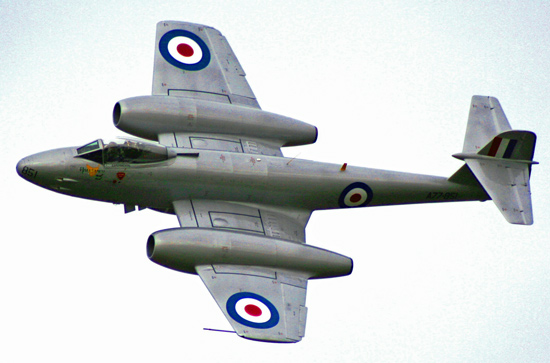Gloster Meteor
(Variants/Other Names: See History
below)

Meteor F.8 VH-MBX, operated by
the Temora Aviation Museum in Australia.
(Photo source unknown. Please contact us if you deserve credit.)
History: The Gloster Meteor entered the
history books as the only turbojet powered aircraft flown in combat by the Allies during
World War Two. It fought V-1 and V-2 rockets, and also served on the other side of the
channel looking for Me 262s and Me 163s.
Eight prototypes of the Meteor were built during development, each with differing engines
of various speeds and powers. The first prototype to fly was the fifth one built. It got
airborne on 5 March 1943 powered by two dH Halford H.I engines, with about 1,500 pounds of
thrust each. The first production batch consisted of 20 Gloster G.41A Meteor
F.Mk Is. These had Welland engines and a clear-view canopy. The first Meteor
was traded to the United States for a Bell YP-59A Airacomet, the USA's first jet fighter.
One was used in an experimental design for the world's first turboprop-driven plane. This
aircraft, the Trent-Meteor, used reduction gears on the engine to drive a propeller shaft
with a five bladed propeller. It was equipped with longer-stroke landing gear to give
clearance for the propeller tips.
The first operational jet fighter squadron was No. 616. It was given a detached flight of
seven Meteor F.Mk Is when it moved to Manston, Kent in July of 1944. RAF Flying Officer
Dean claimed the first V-1 to be destroyed by a jet fighter. After all four of his guns
jammed, he used his wing tip to push the V-1 nose-first towards the ground. The same day
another Meteor claimed a second V-1. By the end of August, the squadron was completely
converted to Meteors. The first Meteor F.Mk IIIs were delivered
on December 18, 1944, and these began to replace the Mk. Is. The Mk IIs
had the much better Derwent turbojets, which improved performance considerably. In January
of 1945, one flight from No. 616 Squadron was moved across the channel to begin operations
in Belgium. After the war, production continued. The most prolific version built was the
Meteor F.Mk 8, with gyro-gunsights, bubble canopy, ejection
seats and bigger Derwent engines, with a top speed of 600 mph (966 km/h). A two-seat, dual
control trainer was built for the RAF under the designation Meteor T.Mk 7,
and a two-seat night fighter, the Meteor NF Mk 13, entered
service in 1952.
When production of the Meteor ended in 1954, 3,947 had been
built. Today, several Meteors are still flying, most in
the UK and at least one in Australia.
Nicknames: Meatbox; Meaty
Whore; Phantom Diver (T.7 version); Reaper (Meteor GAF version)
Specifications (F.Mk I):
Engines: Two 1,700-pound thrust Rolls-Royce W.2B/23C Welland turbojets
Weight: Empty 8,140 lbs., Max
Takeoff 13,795 lbs.
Wing Span: 43ft. 0in.
Length: 41ft. 3in.
Height: 13ft. 0in.
Performance:
Maximum Speed at
10,000 ft: 415 mph
Ceiling: 40,000
ft.
Range: 550 miles
Armament: Four 20-mm cannon
Number Built: 3,947
Number Still Airworthy: Approximately
4
Links:
CNAPG Meteor Page
The Flightline WWII Aviation
Archive: Meteor Page
Greg Goebels' VectorSite:
Meteor Development and History -- A very comprehensive history of the Meteor.
Imperial War Museum Meteor F.8, Duxford, UK
Meteor Flight -- An excellent reference
and historical resource.
Meteor in Israeli
Air Force Service
Meteor Page (in
French)
Temora Aviation Museum's Meteor F.8
Vic
Flintham's Meteor Site -- Another excellent site about the Meteor.

[Back to Warbird Alley's Main
Page]
All text and photos Copyright 2016 The
Doublestar Group, unless otherwise noted.
You may use this page for your own, non-commercial reference purposes only.
 |